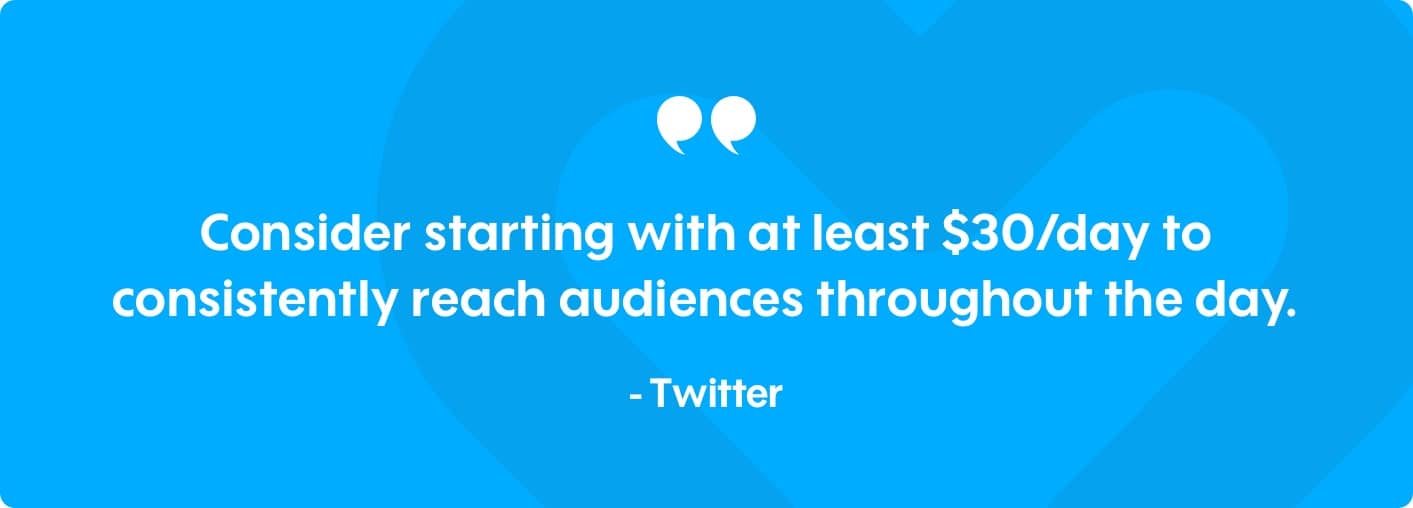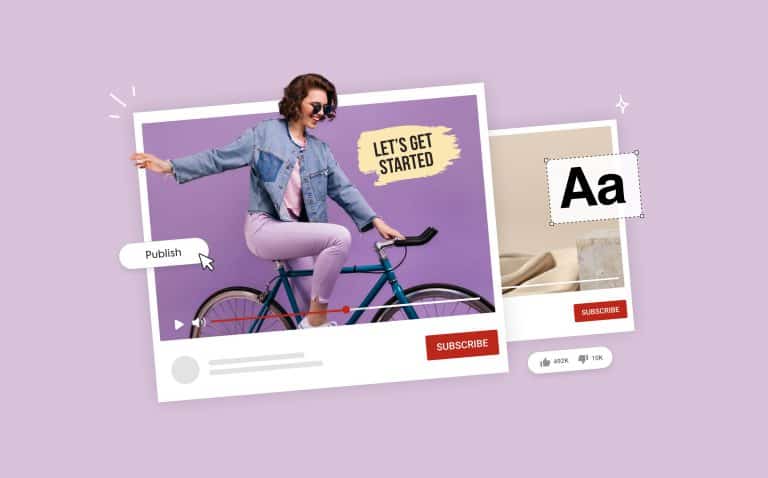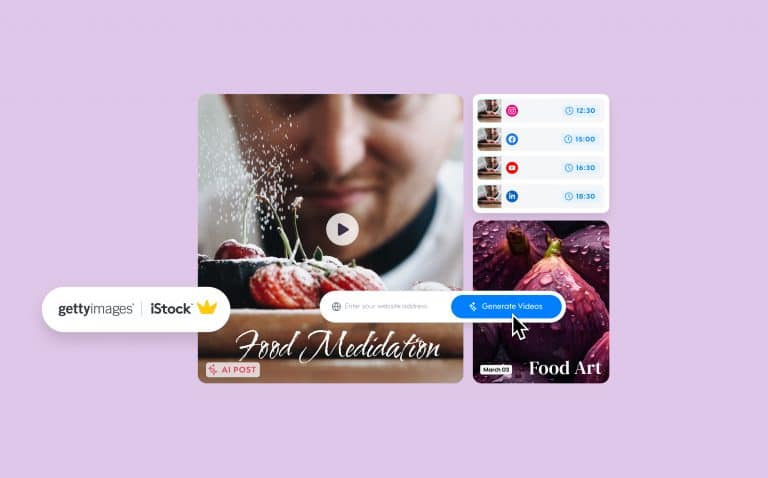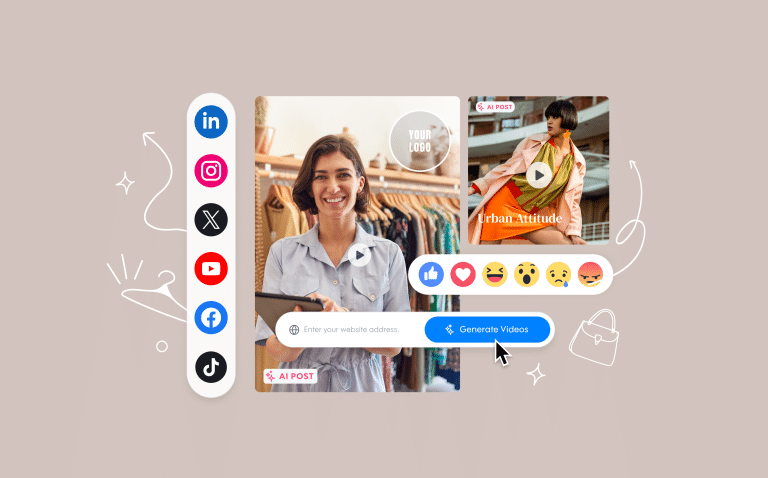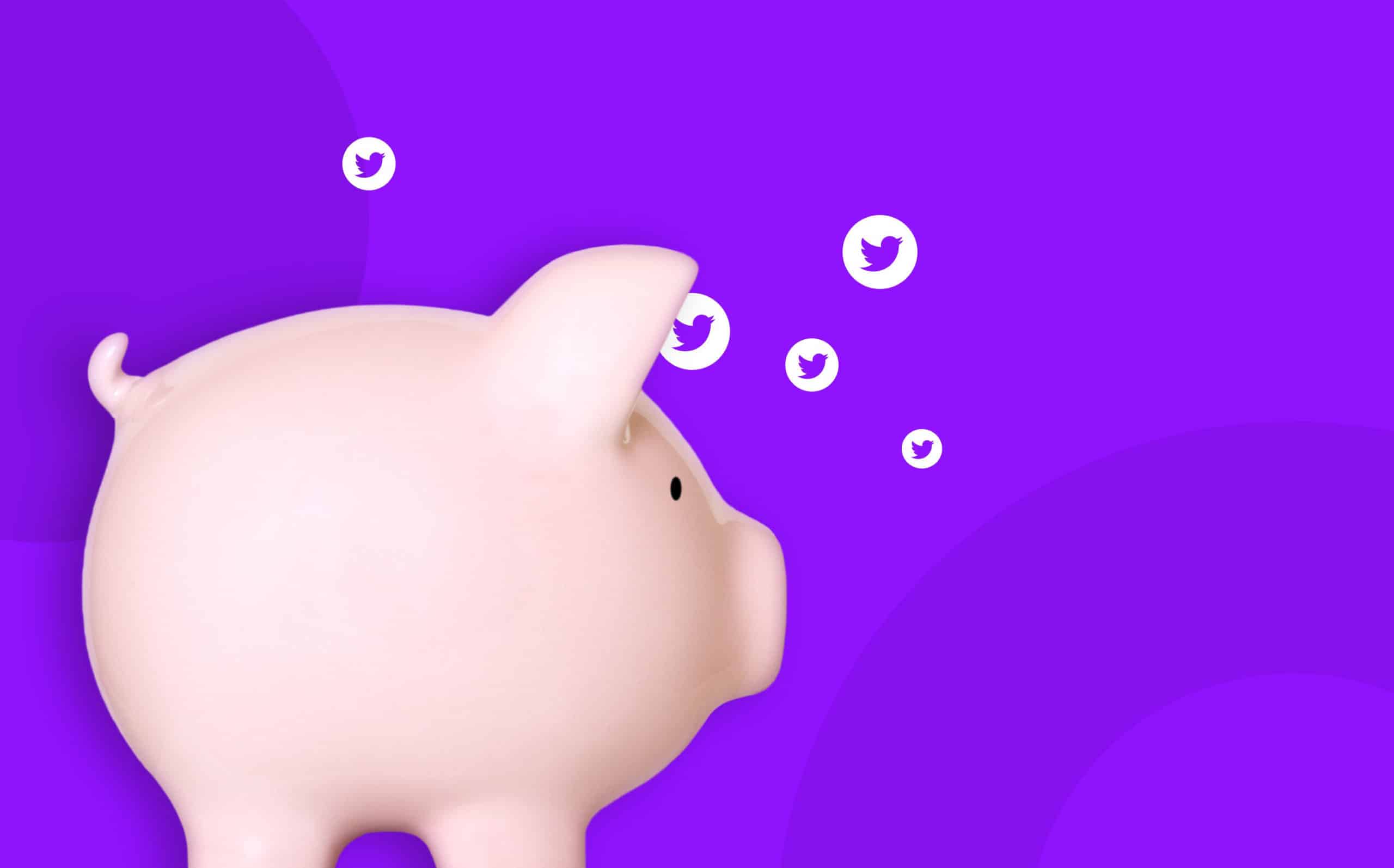
How Much Does It Cost to Advertise on Twitter?
While Twitter may be considered “old” in terms of social media platforms, it’s still very much alive and kicking with more than 326M active monthly users and an extra 500M people who visit the site every month without logging in. Needless to say, it can be an effective platform to advertise your business.
But if you’re here, you already know why you should advertise on Twitter so let’s get right to the point and ask the questions that are scratching at your wallet…
Should you be investing in Twitter Advertising? And what’s the cost of Twitter advertising anyway?
Great questions! Let’s get you some answers.
Twitter marketing and ROI
Twitter worked with a third-party company to analyze various ads over a two-year period and what they found was that Twitter ads had an ROI that was 40% higher than any other platform.
In their research, they found that “for every dollar spent on Twitter ad campaigns, the four brands in the study averaged a return of $2.70.”
While some B2B businesses struggle to make ads work for them on certain platforms, HubSpot found that Twitter ads were responsible for “driving new business at a 46% lower cost per lead, but our lead conversion rate is also 48% higher on Twitter compared to other platforms.” In fact, their ROI was marked at 32 percent. In the online advertising world, that sort of thing is pretty much unheard of.
Okay, now that we’ve established Twitter’s exceptionally high ROI, let’s take a look at the actual cash money cost of advertising on the platform.
The cost of Twitter advertising
Let’s start with the best part: Freebies.
Like most other social media platforms, Twitter is free to use. However, Twitter is unique in that their hashtag and the @mention system makes it much easier than other platforms to gain good reach. In fact, with a good mixture of newsjacking (relevancy) + hilarity, you may get lucky and have your Tweet go viral or have someone download your Twitter video. Sort of like what happened with this guy who doesn’t have a big following but still has over 30K retweets.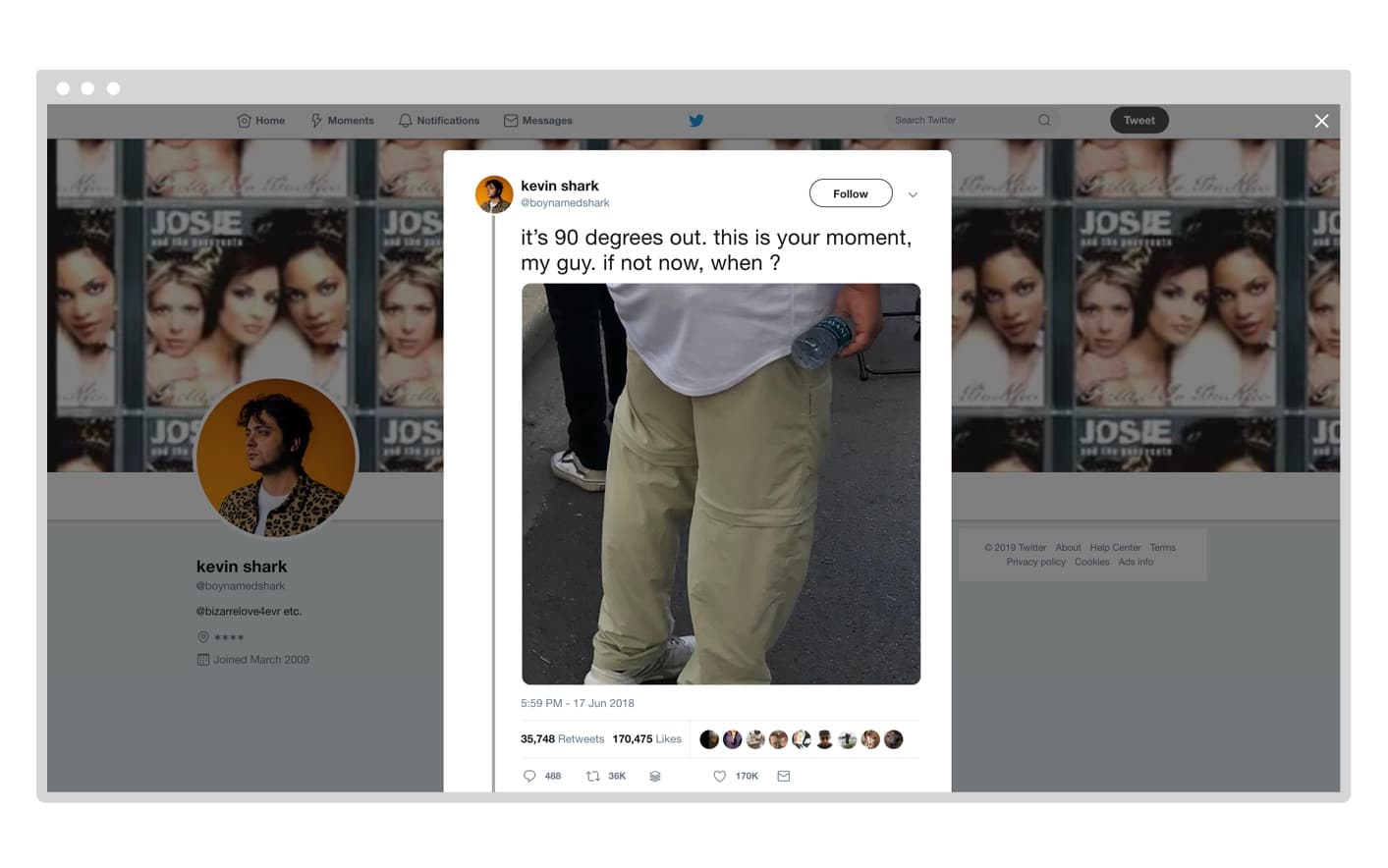 So, why pay?
So, why pay?
While organic posts can have decent engagement, it’s more of a gamble to hit that “Gone Viral” bell.
You do have to pay for ads to consistently get reach and engagement, but, you’ll be happy to know that ads cost only as much as you’re willing to spend.
Like other advertising platforms, you have complete control of your budget and Twitter will only use your allowed budget to bid and pay for your ads that run the course of your campaign.
When you’re setting up an ad on Twitter, you have a couple of budget options: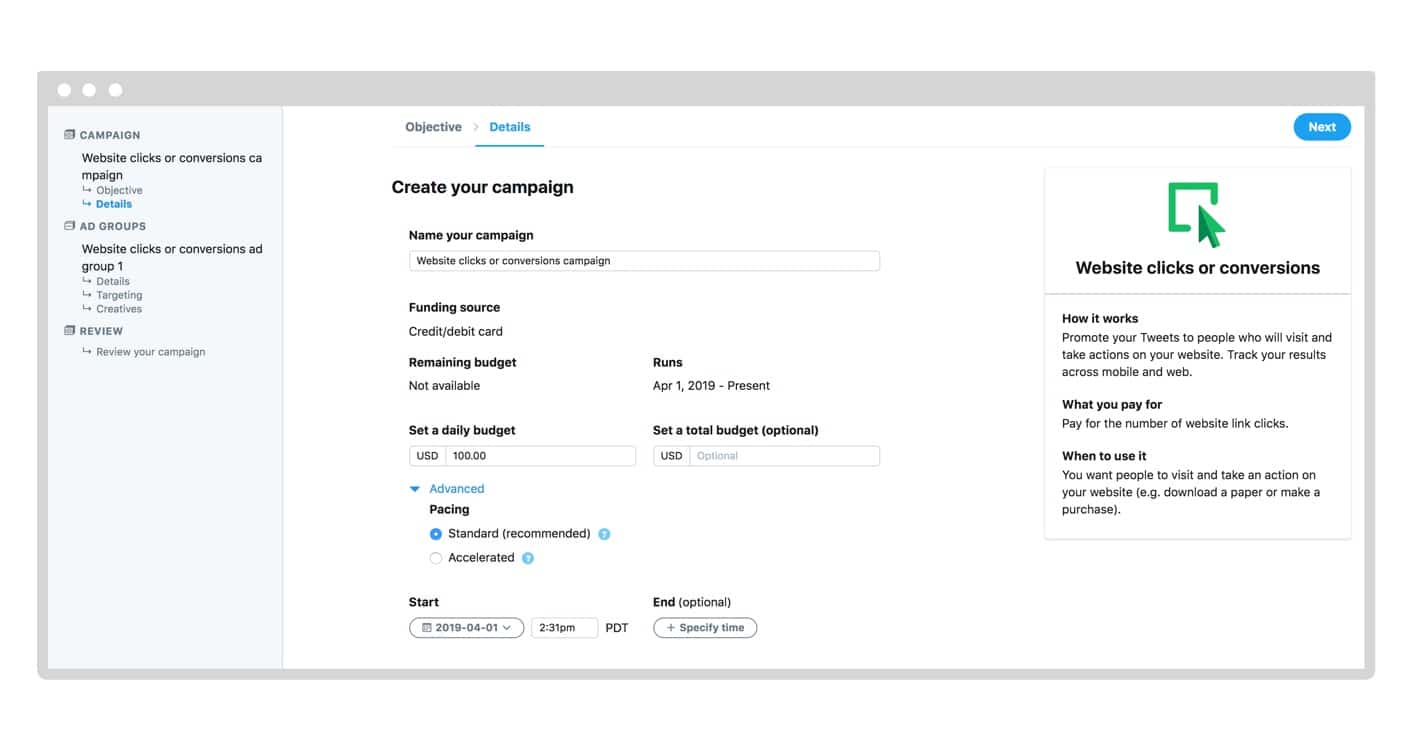
- Set a daily budget. You enter the amount you want to spend each day on your ads.
- Set a total budget. This is the option you choose if you don’t want to go over a set amount. Once you hit your budget limit here, the campaign will automatically stop showing your ads.
So for instance, if you only want to spend $5 per day on your ads over the course of a few weeks, you can do that with a daily budget and set an end date. If you want to spend $100 in total but only run your ads for a weekend, you can set a total budget.
Twitter suggests “starting with at least $30/day to consistently reach audiences throughout the day.”
What’s the average cost of advertising on Twitter?
We know you’re dying to get an answer to this one and while averages vary by industry and objective, you’ll be happy to know that the numbers are pretty good.
Adstage did some digging during Q1 of 2018 and this is what they found:
- Ads set at for CPM (cost-per-1000-impression) was $6.46
- Ads averaged a $0.38 CPC (cost-per-click)
However, our Twitter advertising guide shows that you can get your CPC as low as $0.10 so there’s definitely some wiggle room there.
As you progress with Twitter advertising in an attempt to expand your outreach and increase your ROI, there are a few cost factors that you should keep in mind.
So, without further ado, let’s go over the variables that impact the cost of your ads and figure out how you can get more for your budget.
6 factors that impact your Twitter ad costs
Before we even get started, here is the most important thing to remember:
The variable that will most impact your cost is your Quality Score. The better quality ads you serve, the lower your ad cost will be.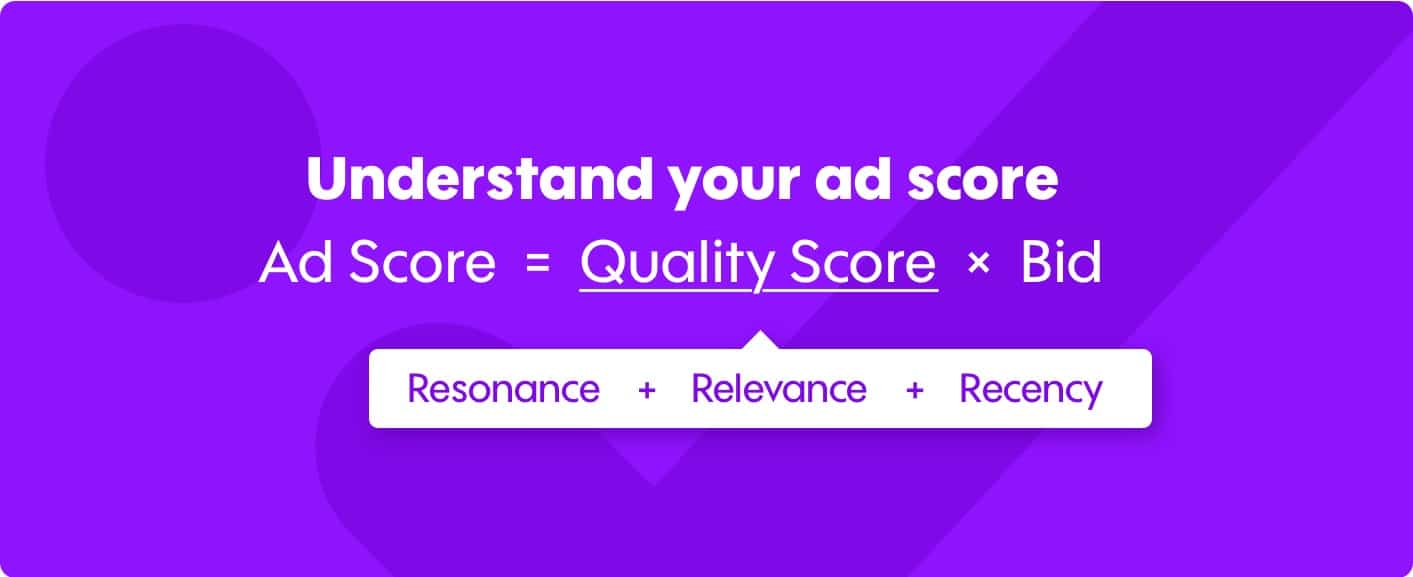
Source: Twitter
- Resonance: Are people engaging with your ad? Do they click, like, and/or Retweet it often?
- Relevance: Does the Tweet’s content align with your audience’s interests?
- Recency: Are your Tweets fresh? Twitter is what’s happening now, so our auctions reward up-to-date content.
If we take a deeper look that the two variables that affect your ad score (and ultimately your cost), we can break them down into 6 different factors:
- Your objective
- Your bidding strategy
- The quality of your ad creatives and videos
- Your ad format
- Your target audience
- Your competition
While you can play with some of these factors in order to lower costs, some are already set as natural derivatives of your industry, marketing goals, and target market.
Let’s take a look!
Cost factor 1: Your objective
The objective you select tells Twitter what’s the goal for your ad.  Twitter currently has 8 to choose from:
Twitter currently has 8 to choose from:
- App installs
- Promoted video views
- Followers
- Tweet engagements
- Website clicks or conversions
- App re-engagements
- In-stream video views (pre-roll)
- Awareness
Take into consideration that each objective is billed differently.
Once you select an objective and strategy, you’ll be able to see a list of charges. For instance, if you choose Promoted Video Views then your cost is automatically set to charge you per view (CPV).
Naturally, some objectives will cost more than others. For instance, “Website clicks or conversions” and “App installs ” is generally going to cost you more than going the route of say, “Tweet engagements.” Those two options have more value for your business and Twitter knows what they’re worth so they’ll charge you accordingly.
Pro-tip: It’s better to choose the best objective for you rather than trying to find the cheapest possible option and lose out on options that are better for your business.
Learn more about each objective, their pros and cons and their setup process in our Twitter advertising guide.
Cost factor #2: Bidding strategy
As we mentioned before, your bidding strategy is based on your chosen objective.
Each bidding strategy will charge you for a different set of billable actions.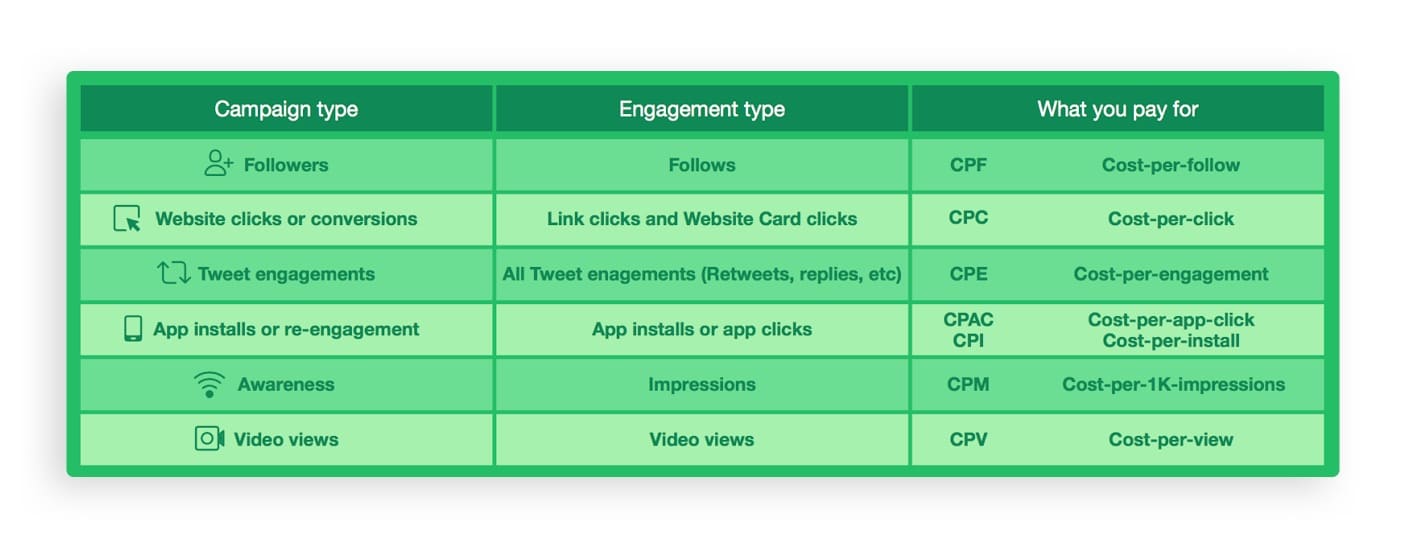 Image Source: Twitter
Image Source: Twitter
Here are the bidding strategies that go with each objective:
- App installs – CPI (cost-per-install), CPAC (Cost-per-app-click)
- Promoted video views – CPV (cost-per-view)
- Followers – CPF (cost-per-follow)
- Tweet engagements – CPM (cost-per-1000-impression)
- Website clicks or conversions – CPC (cost-per-click)
- App re-engagements –CPI and, CPAC
- In-stream video views (pre-roll) – CPV
- Awareness – CPM
This factor is essentially tied to the previous one as choosing an objective automatically sets your bidding strategy.
Cost factor #3: The quality of your ad creatives and videos
Unlike the other two options above, this is something that you can (and should) control.
The quality of your ad plays an important role in lowering your cost and boosting your ad’s performance.
To determine the quality of your ad, ask yourself “Does your ad resonate with your target audience?”
If your ad creatives like images — and especially video — are blurry, then you can bet that it will resonate with no one! We live in a highly visual world and people have come to expect high-quality, non-blurry images and video ads. More than that, Twitter expects it too.
It’s important to invest in quality content, so you don’t end up paying a lot to advertise while also not attracting the right kind of engagement.
Video content is always recommended as it wields a lot of power on Twitter. Just take a look at these stats:
- 93% of Twitter’s video views take place on mobile devices
- “People who view videos on Twitter are 50% more likely to be aware of an advertiser’s brand”
- “ Videos on Twitter are 2x as memorable as those on other premium platforms”
- “ People who view videos on Twitter feel 14% more favorable about the brand”
- “Videos on Twitter increase the average lift in intent by 34%”
A video maker tool like Promo.com can help you quickly (and affordably) create high-quality videos that will resonate with your targeting audience.
We recommend testing two video ad sets to find which one that is performing best and why. You can then isolate the variables that cause your video to perform better so and apply them to all your new videos
Cost factor #4: Your ad formats
There are only a few ad format options on Twitter:
- Promoted Tweets (Photos & Videos). This turns any Tweet in your brands account into an ad.
- Promoted Accounts. This ad format promotes your Twitter account instead of certain tweets.
- Promoted Trends. For most brands, Promoted Trends won’t be an option for a couple of reasons. First, it’s not open to the public since Twitter reserves it for certain brand deals. Second, rumor has it that you’d have to spend around $200K (yes, that’s right) to even use that. So that option isn’t something we need to worry about.
- Twitter Promote Mode. This option was introduced back in 2017 and it’s pretty much a fully automated advertising method. And guess what? It only costs $99 per month.
From a budget standpoint, Twitter Promote Mode can be a great way to get started with Twitter ads to see how they work for you. As the cost is $99 per month, it’s sure to fit in most small business budgets. If you want to go the more traditional route of selecting individual Tweets to promote then you can do that through the Twitter Ads dashboard, or you can actually use both in tandem.
How much does it cost to promote a Tweet? Promoted Tweets cost an average of $1.35 per engagement (CPA), while Promoted Accounts tend to range from $2.50-$4.00 per confirmed follower. So generally speaking, the route of using Promoted Tweets is going to be the cheaper option here.
Keep in mind that you can lower that average CPA (cost-per-action) when you make a concentrated effort to improve your Quality Score.
Cost factor #5: Your audience targeting (campaign targeting)
Twitter has some of the most impressive targeting options of any of the ad platforms out there. You can target by behavior, device, region, interest, age, and the list goes on and on.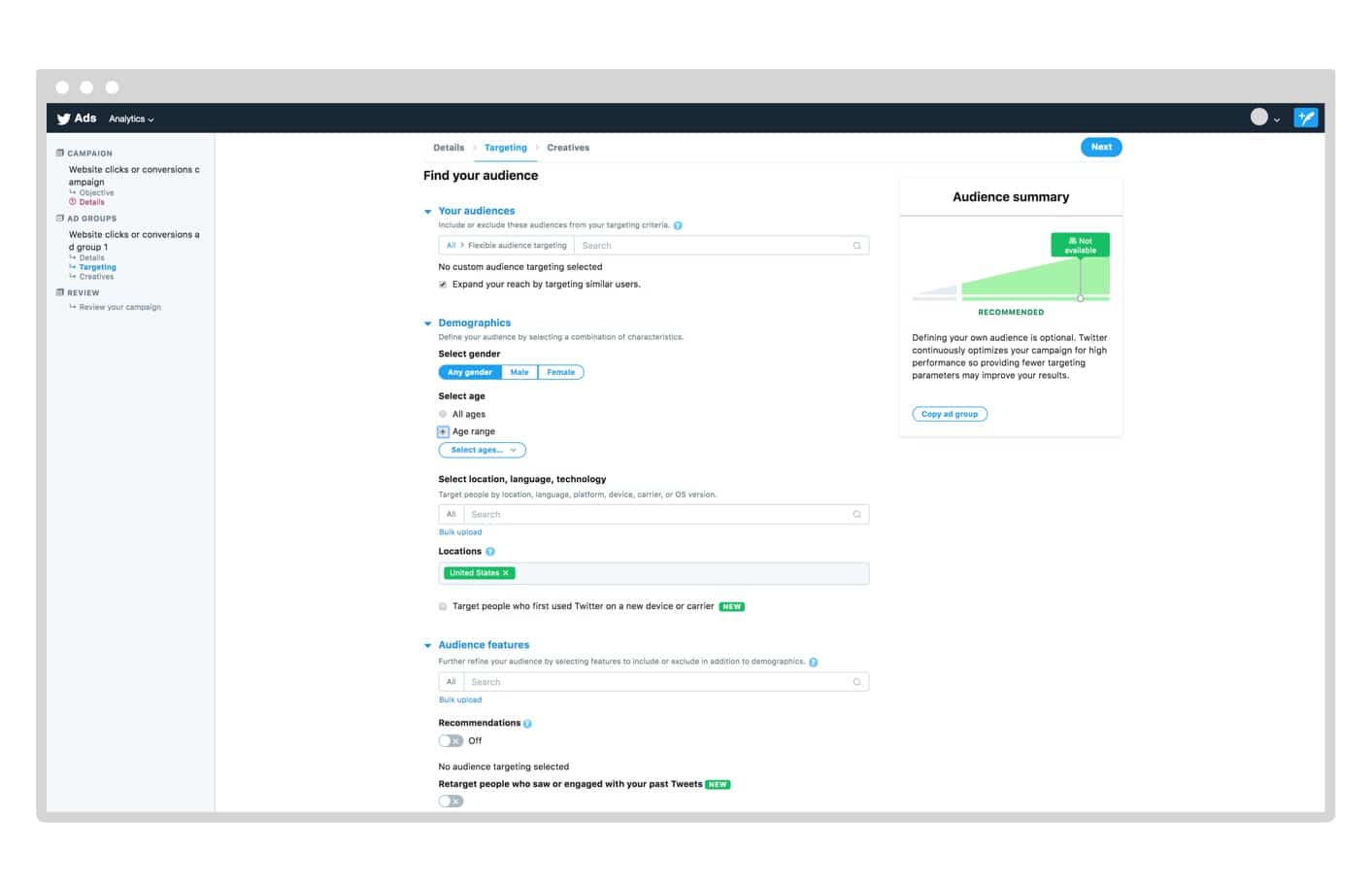 The audience you target and how you target them will also affect your costs. It goes back to 1 of the 3 R’s of your Quality Score.
The audience you target and how you target them will also affect your costs. It goes back to 1 of the 3 R’s of your Quality Score.
Resonance; you have to make sure your message will resonate with the audience you’re targeting. If not, your engagement will drop and your prices will increase.
The folks over at WordStream tested this out and found just how important your engagement rate is in relation to your ads. You can read up on their test and how it affected their costs.
You also don’t want to narrow your audience down so much that you decrease reach.
Unlike other platforms, your industry and/or verticle doesn’t seem to have an impact on what you’re paying. However, if you’re targeting an industry that has a lot of competition then, yes, you should expect to pay more.
The best way to lower costs here is to test your ads with various targeting options as you go along. You can also check out this resource on Twitter to give you an idea of all the campaign targeting options so you can find some hidden gems that you may not have considered.
Cost factor #6: Your competition
Finally, we have your competitors.
Every ad platform has them and just like any other platform you’ll be bidding against them to get your ads on Twitter.
In the case of Twitter, both the audience your targeting and the competitors you’re bidding against will impact your costs.
For instance, if you’re targeting a highly competitive interest like “Basketball,” then you should expect to be paying more than if you’re targeting something that isn’t as competitive. However, Twitter does use what’s called a Second Price Auction to help even out costs.
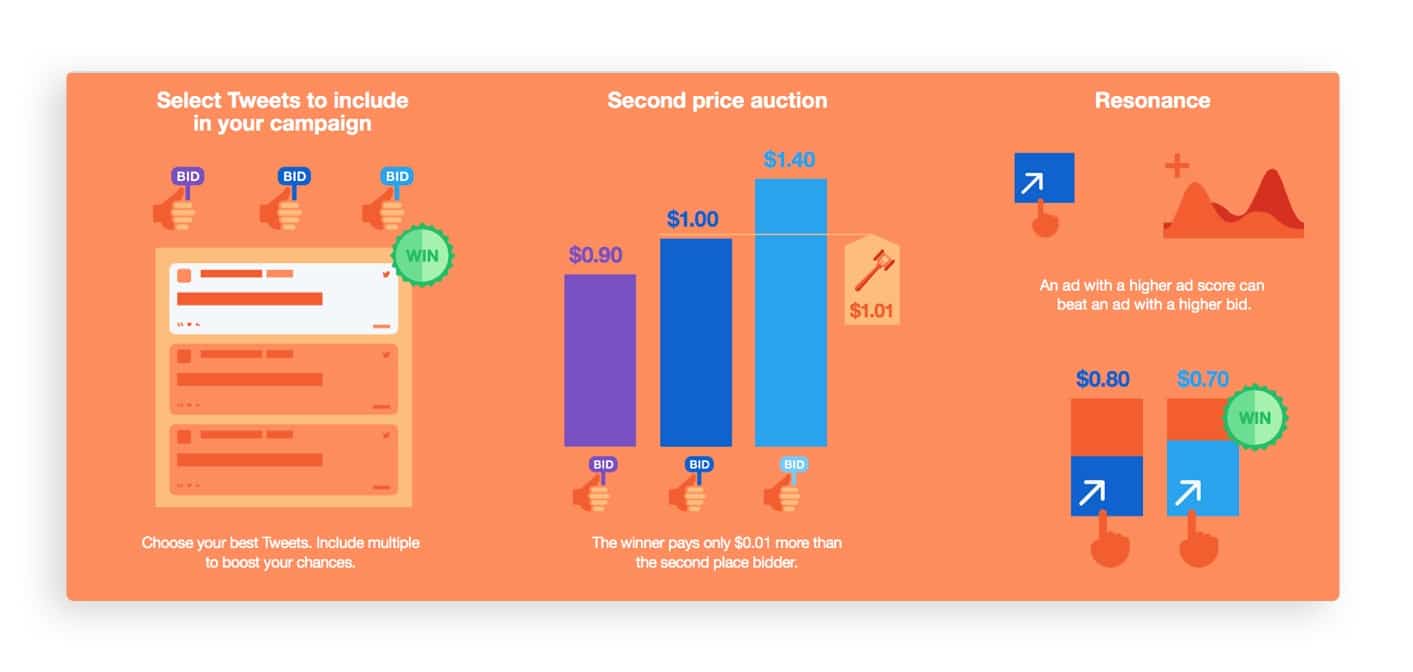 Source: Twitter
Source: Twitter
This is how it works:
“If you bid $1.40 and beat an otherwise identical ad bidding $1.00, your campaign will be charged $1.01 if the user it was shown to makes the billable action.” (Source)
So even if you enter your bid at a higher cost then your competitors, if the quality of your ad is better, you’ll only pay $0.01 more than the second place bidder which is pretty good news from a budget standpoint. You can’t change the fact that you’re bidding against competitors, however, you don’t need the highest bid to win. You just need an ad with the best quality for your audience.
Another thing to keep in mind is the time of year. Competitors flood the ad platforms for holidays and big events like the Super Bowl which can increase your ad costs during that time of year. Interestingly, though, Hootsuite found that “Twitter posted a 50% increase in ad engagements between October 2017 and 2018” and “saw a 14% decline in cost per engagement over the same period.”
So while the time of year can increase costs, it can also increase in engagements too. This also brings up the point that you should take time ever so often to check on the performance of your ads and measure how they’re performing.
Studying metrics like CPA, CTR (click-through-rate) or measuring ROI — especially during busy times of the year — can help you approach your ads differently and take into account relevant things happening to help lower ad costs while increasing your Quality Score.
Twitter users love video content. Use it and Twitter will show you some love with lower costs.
This resource from Twitter can give you some good insights as far as how to measure your campaigns for success. Video ads on Twitter tend to be the best performing ads and there is plenty of evidence to support this:
- 82% of Twitter users watch video content on Twitter.
- “Native videos on Twitter drive more engagement than third-party videos shared on Twitter. Specifically, 2.5x more replies, 2.8x more retweets, and 1.9x more likes/favorites.” (Source)
- “Tweets with video attracted 10x more engagement over Tweets without video. In addition, Promoted Tweets with videos saved more than 50% on their cost-per-engagement, helping their ad budgets stretch further.” (Source)
You can do Pre-Roll ads, which are similar to YouTube TrueView ads and play before another video or you can use a Promoted Tweet that has contains a video. If you’re wondering what type of video you should use, the folks over at Instapage have some great ideas that you should look at to help get the ideas rolling.
With so much love on Twitter for video content, it just makes sense to start there for your ad campaigns. The Promo.com video maker comes with everything you need to easily create engaging Twitter video ads that can positively impact your Ad Quality Score.
[banner id=11527]

